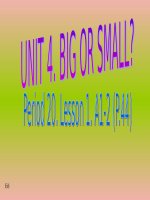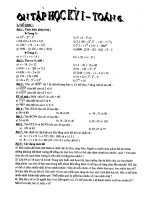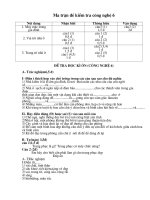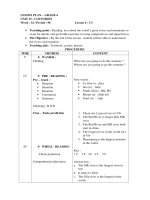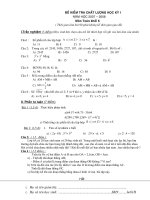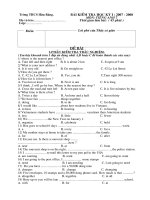English 6 (Ki 2)
Bạn đang xem bản rút gọn của tài liệu. Xem và tải ngay bản đầy đủ của tài liệu tại đây (336.19 KB, 86 trang )
: 11 /01 / 2007
Teach: 18/ 01 / 2007
Unit 9
The body
Period 55: a. parts of the body (a1, a2)
I. Objectives
By the end of the lesson, students will be able to :
- Call the name of body’s parts
III. Contents:
Structures: what is that? What are those?
That is his head Those are his fingers.
Vocabulary: head shoulder arm chest hand
Finger leg foot toes
IV. Teaching methods: Communicative method.
V. Teaching aids: Textbook, cassette, sub-board,
A body pictures.
VI. Procedure
Teacher and students activities’ Content of lesson
1. Warm up
* Greeting, date
* Absent Ss: 6a 6b
T: ask Ss to plays a game “Guessing game”
- Write a word on the board, for example: “X” and
introduces “X” is a part of body.
T: Ask Ss to make some questions and guess what is
“X”
Ss: Look at the board and listen teacher’s introduce
Ss: Make questions:
“Does a person have two “X”?
Is “X” long?
T: Introduces the content of today’s lesson
2. Presentation:
T: Hand on a body picture as picture A1 and reject
the name of body’s parts
Ss: Listen to the tape and look at teacher’s activities
to know the name of body’s parts
T: Point at parts of body
Ss: Listen to the tape two times and read in chorus.
T: Write new words and explain the meaning
1. Listen and repeat.
1
T: Call on Ss to read the new words in chorus
Ss: Read new words again
T: Point at each part of body and ask:
What is that?
What are those?
Ss: Observe and answer teacher’s questions
Ex: That is his leg.
Those are fingers
T: Write down the modal of sentences on the board
and ask Ss to read.
Ss: Write down the modals
3. Practice
T: Ask Ss to look at exercise A2, practice asking and
answering the questions
Ss: Practice in pairs then change the role
Ex: P1: what are those?
P2: those are his arms.
T: Calls some pairs to practice
Ss: One student point at each part of body to ask and
others to answer.
Ex:
What is that?
That s his head’
What are those?
Those are his arms.
T: Corrects the mistakes
4. Consolidation:
T: Ask Ss to play “guessing game” with words given
a. It is on the top of your body.
What is it?
b. they are at the end of your legs?
What are they?
c. it is between your arms. What is it?
d. they are on your hands. What are they?
Ss: Practice asking and answering in pairs
T: Repeat the parts of body.
5. Homework
- Learn by heart the name of body’s parts.
- Do all exercises at workbook
- Prepare the next period (A3,4)
New words:
Head (n): ®Çu
Arm (n): c¸nh tay
Chest (n): ngùc
Leg (n): c¼ng ch©n
Foot (n): bµn ch©n (feed) sè nhiÒu
Hand (n): bµn tay
Finger (n): ngãn tay
Shoulder (n): vai
2. listen and repeat
Answers:
a. head
b. feet
c. chest
d. fingers
2
Prepare: 12 / 01 / 2007
Teach: 19 / 01 / 2007
Unit 9
The body
Period 56: a. parts of the body (a3, a4)
I. Objectives
By the end of the lesson, students will be able to :
- describe simply a personal appearance
III. Contents:
Structures: he is fat
She is thin
Vocabulary: big tall fat heavy strong
Small short thin light
IV. Teaching methods: speaking and listening
V. Teaching aids: Textbook, tape, cassette, sub-board, chalk
VI. Procedure
Teacher and students activities’ Content of lesson
1. Warm up
* Greeting, date
* Absent Ss: 6a 6b
- Checking the old lesson:
T: Hand on a picture, calls a student to write and say
the name of body’s parts.
T: introduce the title of the lesson (describe a
personal appearance)
2. Presentation:
T: Ask Ss to look at the pictures A3 and compare
appearance of characters in each picture
(A – b): a – cao; b – thÊp
(c – d): c – gÇy; d – bÐo
T: Write the words on the board and ask Ss to guess
the meaning of these words
Tall ><short
Thin >< fat
Light >< heavy
Ss: Look at the board, guessing the meaning and
write down new words
T: Gives the meaningful and ask Ss to read in chorus
Ss: Listen and read in chorus
T: Play the tape 3 times (A3)
3. listen and repeat
New words
Tall (a): cao
Short (a): thÊp
Fat (a): bÐo
Thin (a): gÇy
Heavy (a): nÆng
Light (a): nhÑ
3
Ss: Listen and repeat each sentence
T: Ask Ss to remark the way to describe a person in
the tape
Ss: Student’s remark
T: Write down the modal of structures to describe a
personal appearance
Ss: Write down the structures
T: Call some students to describe appearance
yourself and their friends in the class.
Ss: Describe appearance yourself
Eg: I am fat or Nga is thin.
3. Practice
T: Ask Ss to complete exercise A4, number the
pictures in order they heard
Ss: Prepare to listen
T: Play the tape (A4) 2 times, ask Ss to listen and
number the pictures
Ss: Listen and number the pictures in order
T: Call some Ss to give their answers
Ss: Read and write down their answers on the board
T: Play the tape one more, repeat each sentence and
check the answers on the board
Ss: Check their answers
4. Consolidation
Repeat how to describe a personal appearance
S + be + adj
5. Homework
- Write a short passage to describe your family
members
- Learn by heart structure to describe a personal
appearance
- Do all exercises at workbook
- Prepare the next period (A5,6,7)
Structures:
S + be + adj
Eg: He is tall
She is short
I am big
They are heavy
4. Which picture? Listen and choose
the right picture.
Answers:
1 – d ; 2 – c
3 – b ; 4 - a
4
Prepare: 15 / 01 / 2007
Teach: 22 / 01 / 2007
Unit 9
The body
Period 57: a. parts of the body (a5,6,7)
I. Objectives
By the end of the lesson, students will be able to :
- practice describing a personal appearance
III. Contents:
Structures: review the structures, they have learnt
Vocabulary: gymnast weight lifter weak strong
IV. Teaching methods: speaking and listening
V. Teaching aids: Textbook, tape, cassette, sub-board, chalk
VI. Procedure
Teacher and students activities’ Content of lesson
1. Warm up
* Greeting, date
* Absent Ss:
- Checking the old lesson:
Describe a member in your family or in your class
2. Pre reading–
T: Introduce reading lesson with 2 short passage talk
about occupation and describe appearance of 2
people Tuan and Chi
T: Introduce new words
T: Help Ss to read new words and explain the
meaning.
Ss: Listen and read new words in chorus
T: Ask Ss to do a listening exercise to check their
listening skill
T: Give Ss work sheets and ask them to read before
a. Chi is a teacher.
b. Shi is tall
c. She is fat
d. She is light and she is weak
e. Tuan is a gymnast
f. He is short
g. He is not fat but he is heavy
h. He is strong
5. Listen and read
New words
Strong > < weak
khoÎ > < yÕu ít
gymnast (n) vËn ®éng viªn thÓ dôc
weight lifter (n): vËn ®éng viªn cñ t¹
5
T: Ask Ss while they listen, read and fill true (ν) or
false (x)
3. While reading–
Ss: Look at the book, listen part of A5 2 times
T: Repeat each sentence for Ss to complete
- Call 2 Ss to read 2 passage (a,b) in the part of A5
Ss: Read the passage and give their answers
T: Correct the mistakes
T: Ask Ss to find out the differences between Chi
and Tuan
Ss: Compare Tuan and Chi
T: Ask Ss to compare the answers with partners
Ss: Exchange their answers each other
T: Call some good students to speak the passage a,b
rely on the table of comparison
4. post reading–
T: Ask Ss to do exercise A6 in pairs
Ss: Practice in pairs
T: Call on some pairs to practice
Ss: Practice with the other people
5. Homework
T: Repeat how to describe a person: appearance,
weight, physical .…
T: Ask Ss to make a dialogue, asking and answering
about appearance, occupation in your family
- Do all exercises at workbook
- Prepare the next period (part B)
Answers:
a x
b v
c x
d v
e x
f v
g x
h v
Comparison between Tuan and Chi
+ Similar: They are strong
+ Difference:
Chi Tuan
Tall >
Thin >
Light >
< short
< fat
< heavy
6
Prepare: 18 / 01 / 2007
Teach: 25/ 01 / 2007
Unit 9
The body
Period 58: B. faces (B1, 2, 3)
I. Objectives
By the end of the lesson, students will be able to :
- Understand some adjectives, noun to describe facial features and the name of colorful
basics to describe physical appearance
III. Contents:
Structures: What color are her eyes?
They are brown.
What color is her hair?
It is black.
Vocabulary: Hair, eye, nose, mouth, ear, lips, teeth, round, oral, full. Black
Yellow, green, gray, blue, red, brown, purple.
IV. Teaching methods: communicative method
V. Teaching aids: Textbook, tape, cassette, sub-board, chalk, picture.
VI. Procedure
Teacher and students activities’ Content of lesson
1. Warm up
* Greeting, date
* Absent Ss: 6a 6b
- Checking the old lesson:
T: Call some Ss to describe physical appearance and
occupations of her/his family members
2. Presentation
T: Use or draw a picture of face to introduce details
of face with other steps
Ss: Look at the draw, listen
Step 1: Draw, read modal, and ask Ss to read in
chorus, individual.
Ss: Write down new words
1. Listen and repeat.
1. face
2. ear(s)
3. hair
7
Ss: Listen and repeat the new words
T: Ask Ss to look at the pictures a -> f and guess the
meaning of the words (around, oval, full, thin, long,
short..
T: Give meaning
Ss: Listen and repeat these new words
T: Play the tape
Ss: Listen to the tape B1 2 times and repeat each
sentence
T: Hand 10 colorful sheets on the board
T: Introduce the word “color” or “colour” is (mÇu
s¾c)
Ss: Look at the colors, listen and repeat
T: Point the items in the classroom and say
The windows are blue
The book is green
4. eye (s)
New words:
Round: trßn
Oval : h×nh tr¸i xoan
Full: ®Çy, ®Çy ®Æn
Thin: máng
Long: dµi
Short: ng¾n
2. Listen and repeat. Colors.
New words
Black: mÇu ®en
Yellow: mÇu vµng
White: mÇu tr¾ng
Green: mÇu xanh l¸ c©y
Grag: mÇu x¸m
Blue: mÇu xanh da trêt
Red: mÇu ®á
Brown: mÇu n©u
Orange: mÇu vµng cam
Purple: mÇu tÝa
Structures
- What color is her hair?
It is yellow
- What color are her lips?
8
5. nose
6. mouth
7. lip (s)
8. tooth
(teeth)
black
yellow
white
green
gray blue
red
brown
orange purple
Ss: Look at the doll and introduce
T: Call some pairs to practice the questions and
answer like these.
3. Practice
Ss: Work in groups 8, look at the dolls in exercise
B3, practice asking and answering about dolls’
colors
T: Ask Ss to choose a doll and practice
T: Help Ss and gives an example
Ss: Choose a doll and practice
T: Call on some groups to practice
Ss: Ask and answer about colors
T: Correct the mistakes
4. consolidation
Review some vocabularies and structures
5. Homework
- Learn by heart all new words and make an example
with a new word
- Do all exercises at workbook and prepare
“B4,5,6,7”
They are red.
3. Practice with a partner
Example
S1: What color is her hair?
S2: It is green
S3: What color are her eyes?
S1: They are brown
S4. Is it this doll?
S2: Yes, it is
9
Prepare: 18 / 01 / 2007
Teach: 25 / 01 / 2007
Unit 9
The body
Period 59: B. faces (b4, 5, 6, 7)
I. Objectives
By the end of the lesson, students will be able to :
- Describe the facial features and a person’s appearance
III. Contents:
Structures: She has long black hair
He is tall and thin
Vocabulary: (review)
IV. Teaching methods: Reading method
V. Teaching aids: Textbook, tape, cassette, sub-board, chalk, picture B4
VI. Procedure
Teacher and students activities’ Content of lesson
1. Warm up
* Greeting, date
* Absent Ss: 6a 6b
- Checking the old lesson:
T: Call on some Ss to write new words and give
some examples
2. Pre- reading
Ss: Look at Miss. Chi’s picture
T: Ask Ss to close the textbook and write about 5
sentences to describe the facial features and a
person’s appearance in the picture
T: Help Ss to use the modal: She has .…………
Eg: she has long hair.
Ss: Practice writing about 5 sentences
T: Call some Ss to read their sentences
Ss: Read their sentences in front of class
3. While reading–
T: Ask Ss to look at textbook B4 and listen to the
tape 2 times
Ss: Listen and repeat each sentence.
T: Ask Ss to check and correct their sentences
Ss: Practice asking and answering the questions
about Chi in pairs
T: Call some pairs to practice and corrects the
mistakes
4. Listen and read.
Eg:
- She is tall
- She is thin
- She has long hair
- …………..
Answers:
a. It is long
b. It is black
c. They are brown
d. It is small
e. They are full
10
4. Post reading –
T: Ask Ss to describe shortly about 4 characters in
the picture B5
Ss: Describe the face of 4 people in the pictures
T: Call 4 Ss to describe the face of 4 people
Ss: Listen to the tape and number the pictures,
exchange the answers.
T: Call some Ss to read the answers and plays the
tape once more.
Ss: Listen and check
T: Correct the mistakes
T: Ask st to read the part “ remember”
5. Consolidation
T: Help Ss to review the new words by “net work”
Short long round oval
Big small thin full
6. Homework
- Write a short passage (5 – 6 sentences) to
describe your friend
- Do all exercises at workbook and prepare “Unit 11.
A.1.2.3.4”
5. listen
a. thin lips, short hair, big nose
b. long hair, full lips, round face.
……………..
Answers:
1. C
2. A
3. D
4. B
7. Remember.
What color is her hair?
It is black
………………………
11
hea
d
face
nos
e
hair
lips
Prepare: 19 / 01 / 2007
Teach: 26 / 01 / 2007
Unit 10
Staying health
Period 60 A. how do you feel? (A1, 2, 3, 4)
I. Objectives
By the end of the lesson, students will be able to :
- Practice asking, answering the feeling and demands
III. Contents:
Grammar: - How do you feel? – I am hungry
- What would you like? I’d like some orange juice
Vocabulary: feel, hungry, thirsty, full, tired, orange, juice, noodle.
IV. Teaching methods: Reading method
V. Teaching aids: Textbook, tape, cassette, sub-board, chalk, pictures
VI. Procedure
Teacher and students activities’ Content of lesson
1. Warm up
* Greeting, date
* Absent Ss: 6a 6b
- Checking the old lesson:
T: Use some pieces of color papers and asks
Eg: What color is it?
It is black.
2. Pre- listening
T: Ask Ss to look at the pictures in A1 and guess
how he/she feels
T: Introduce the new words
Ss: Listen and repeat after the tape
T: Introduce the structures
T: Ask some Ss
3. While listening–
T: Introduces the contents of exercise A3; “Ba, Nam,
Lan and Ba hái vµ tr¶ lêi vÒ c¶m gi¸c vµ nhu cÇu
1. Listen and repeat.
How do you feel?
- Hungry: ®ãi
- Thirsty: kh¸t
- Full: no
- Hot: nãng
- Cold: l¹nh
- Tired: mÖt
• Structures:
- How do you feel?
- I am hungry/thirsty…
- What would you like?
- I’d like some orange juice
(These are police questions)
I’d like = I would like
3. Listen and repeat. What would you
like?
12
dïng ®å ¨n, ®å uèng”
T: Play the tape 2 times
Ss: Listen and repeat
- Practice the dialogue in pairs
T: Call some pairs to practice
T: Ask Ss to practice asking and answering the
questions about A3.
1. How does Lan feel?
2. What would she like>
3. How does Nam feel?
4. What would he like?
5. How does Ba feel?
6. What would he like?
7. Would Lan like noodles?
8. Would Ba like noodles?
T: Ask Ss to practice asking about Ba, Nam and Lan
in the book (page 106) in pairs
4. Post listening –
Ss: Look at pictures in exercise A1 and practice in
pairs
T: Call some pairs to practice and corrects
5. Consolidation
- Structures:
+ How do you feel? I’m .…
+ What would you like? I’d like…
6. Homework
- Review the lesson, structures
- Prepare (A5,6,7)
4. Ask and answer about Nam, Lan
and Ba.
Answers:
1. She feel thirsty
2. she’d like some orange juice
3. He feels hungry
4. He’d like noodles
5. He feels tired
6. He’d like to sit down
7. No, she wouldn’t
8. No, he wouldn’t
* Example exchange:
S1: How does Lan feel?
S2: He feels hot and thirsty
S1: What would she like?
S2: She’d like some orange juice
* Example exchanges:
S1: How does he feel?
S2: He feels hungry
S3: …………
S4: ………………
13
Prepare: 22 / 01 / 2007
Teach: 29 / 01 / 2007
Unit 10
Staying health
Period 61 A. how do you feel? (A5, 6, 7)
I. Objectives
By the end of the lesson, students will be able to :
- Read dialogue to recognize Requests with “what do you want?” and “ I want ”…
III. Contents:
Structures: What do you want? I want ..…
Vocabulary: Want.
IV. Teaching methods: listening method
V. Teaching aids: Textbook, tape, cassette, chalk,
VI. Procedure
Teacher and students activities’ Content of lesson
1. Warm up
* Greeting, date
* Absent Ss:
- Checking the old lesson:
T: Ask Ss:
- How do you feel?
- What would you like?
Ss: Answer
2. Pre listening–
T: Ask Ss to look at the pictures in A5 and give
remarks
Ss: Look at the pictures and give remarks
Eg:
a. He is hungry
He’d like noodles
T: Call on some Ss to give remarks
T: Give remarks
b. she is thirsty, she’d like a drink
c. she is tired, she’d like to sit down
d. she is cold, she’d like a hot drink
e. He is sleepy, he’d like to sleep.
f. He is full, he’d like to play
T: Explain the order of the exercise
Ss: Listen to the tape 2 times and do the exercise
5. Listen and match the names with
the right pictures
• Answers
14
- Listen again and check
T: Call some Ss to check the answers
T: Ask Ss to complete the dialogue with the correct
words
A: what (1) the matter?……
B: I (2) .cold……
A: What (3) ..you (4) .?…… …
B: I (5) a hot drink.……
Ss: Listen to the tape in exercise A6 and complete
the dialogue.
3. While listening–
Ss; Look at exercise A6 listen and repeat 3 times
Ss: Practice the dialogue in pairs
T: Introduce the structures
T: Correct the exercise given above
(1) is (3) do (5) want
(2) am (4)want
T: Ask Ss to make new dialogue with the words
given.
A. hot/cold drink
B. hungry/noodles
C. thirsty/drink
Ss: Practice in pairs
T: call some pairs to practices
T: Correct the mistakes
4. Post - listening
T: Repeat some structures
What do you want?
I want ..…
What is the matter?
5. Homework
Review the lesson
Write a dialogue as in the dialogue in A6
Prepare (B1,2,3)
Phuong: b
Nhan: a
Ba: f
Huong: d
6. Listen and repeat. Then practice
with a partner.
S1: what’s the matter? Dung.
S2: I am cold
S1: What do you want?
S2: I want a hot drink
* What’s the matter? (is the same
meaning as “how do you feel?”
Want (v): muèn
Eg: I want some noodles
* Example exchanges:
a. S1: What is the matter, Linh?
S2: I am hot
S1: What do you want?
S2: I want a cold drink.
15
Prepare: 24 / 01 / 2007
Teach: 31 / 01 / 2007
Unit 10
Staying health
Period 62 B. Food and drink (b1, 2, 3)
I. Objectives
By the end of the lesson, students will be able to :
- Call the name of some food and drink
- The usage of “some” and “ any”
III. Contents:
Structures: - What is for lunch? - are there any noodles?
- is there any meat? - Yes, there are some.
Yes, there’s some. No, there aren’t any.
No, there isn’t any. What is there to drink?
Vocabulary: apple orange banana water
Rice milk meat vegetables
IV. Teaching methods: listening method
V. Teaching aids: Textbook, tape, cassette, chalk, real items
VI. Procedure
Teacher and students activities’ Content of lesson
1. Warm up
* Greeting, date
* Absent Ss: 6a 6b
- Checking the old lesson:
T: Ask Ss to answer the questions
+ How do you feel?
+ What would you like? (noodles)
+ Would you like some orange juice?
2. Pre - listening
Ss: look at the pictures in exercise B1 and guess the
name of each item.
T: Point each items and ask “what is it in English?”
T: Use the real items and introduce the new words
Ss: Listen to the tape and repeat 2 times
T: Call some Ss to read the new words
T: Introduce the structures
1. Listen and repeat.
* New words
Apple: t¸o
Orange: cam
Banana: chuèi
Water: níc
Rice: g¹o
Milk: s÷a
Meat: thÞt
Vegetables: rau
* New structures:
16
Ss: Look at the items in B1 and answer the questions
T: Introduce “you’ll hear a conversation about Thu
and Phuong. They are talking about the food and
drink for lunch”
Ss: Copy the table and find out the food or drink Thu
and Phuong eat and drink for lunch.
3. While - listening
T: Call some Ss to complete the table above
T: Call some pairs to practice the dialogue in pairs
T: Introduces the structures
Ss: Practice asking and answering the questions
T: Explain the usage of “some” and “any”
T: Ask Ss to answer the questions in exercise B2
1. What’s for lunch?
2. Are there any arranges and some banana?
3. Is there any water?
4. Are there any noodles?
5. What’s there to drink?
Ss: Answer
T: Call on some Ss to check and correct
4. Post - listening
T: Repeat the structures in the lesson
- What’s for lunch?
- Is there any ?…
- Yes, there is/ No, there isn’t
- Are there any ?…
- Yes, there are some…
- No, there aren’t any…
- What is there to drink?
There is some water
- What is there to eat?
* Examples:
S1: What’s there to drink?
S2: There’s some water and milk
S1: What’s there to eat?
S2: There is some meat, rice …
Noodles
Banana
Meat
Milk
Rice
Water
Orange
- What’s for lunch? Breakfast? Dinner?
* Example exchanges
S1: What’s for breakfast?
S2: There are some noodles
S1: What’s for dinner?
S2: There is some rice and vegetables
- Some: mét vµi.
- Any: Nµo; c¸i nµo.
+ Some: Dïng trong c©u kh¼ng ®Þnh
+ Any: Dïng trong c©u hái vµ c©u phñ
®Þnh
2. Listen and repeat. Then practice in
pairs
* Answers
1. There is some meat and some rice.
2. Yes, there are some oranges and some
bananas
3. Yes, there is some water
4. No, there aren’t any noodles
5. There is some water.
3. Ask and answer.
Is there any ?…
Yes, there is some…
…….
17
-What is there to drink / eat?
5. Homework
- Learn by heart all the new words
- Make sentences, using the structures above
- Prepare “B4,5”
18
Prepare: 25 / 01 / 2007
Teach: 01 / 01 / 2007
Unit 10
Staying health
Period 63 B. Food and drink (b4, 5)
I. Objectives
By the end of the lesson, students will be able to :
- Call the name of some food and drink
III. Contents:
Vocabulary: fish chicken bread orange juice
IV. Teaching methods: communicative method
V. Teaching aids: Textbook, tape, cassette, chalk, real items, and menu
VI. Procedure
Teacher and students activities’ Content of lesson
1. Warm up
* Greeting, date
* Absent Ss: 6a 6b
- Checking the old lesson:
T: Ask Ss to answer the questions
2. Presentation
T: Introduce the menu in the book and say “this is a
menu”
Ss: Guess the meaning “menu”
- say the name of the food and drink in the menu
T: write the new words in the board
Ss: Listen and repeat the new words
Ss: Copy them
- Listen to the exchange and repeat 2 times
3. Practice
T: ask Ss to make new dialogue like one in the text
book
4. Listen and repeat. Then practice
the dialogue with a partner
* New words:
Menu: Thùc ®¬n
Fish: C¸
Chicken: ThÞt gµ
Bread: B¸nh m×
* Example exchanges:
A:
I/hot
I/like/cold drink
What/you /like?
B:
I/not hot. I/hungry/I/like/bread
S1: I am hot
I’d like a cold drink
What would you like?
S2: I am not hot
I am cold
19
Ss: Look at the picture in exercise B5 and realize the
name of each items
T: Say the order of the exercise
- Play the tape 2 times
Ss: Listen and do exercise
T: Call on some Ss to read the answers
Ss: Listen again and check
T: Correct and give answers
4. Consolidation
- What would you like?
I’d like .…
- Would you like fish?
- Vocabulary: fish, chicken, bread
5. Homework
- Learn by heart all new words, write the food or
drink which you like.
- Prepare “C1,2)
I’d like a hot drink
5. Listen. Match the name of the
people with what they would like
* Answers:
Nhan: c, f
Tuan: a, d
Huong: e, g
Mai: b, h
20
Prepare: 26 / 01 / 2007
Teach: 02 / 02 / 2007
Unit 10
Staying healthy
Period 64: c. my favorite food (c1, c2)
I. Objectives.
By the end of the lesson, Ss will be able to talk about food and drink to contrast Would
you like? with Do you like?
II. Contents:
1. Vocabulary: carrot; tomato; lettuce; potato; bean; pea; cabbage; onion.
2. Structures: + I like .
+ I dont like .
+ Do you like .? Yes, I do. / No, I dont.
III. Teaching methods: Communication method.
IV. Teaching aids: Cassette; real item.
V. Procedures:
Teacher s and students activities Contents
1.Warm up:
Absent Ss:
Checking the old lesson: Write names of 5
food or drink do you like to eat / drink.
2. Presentation:
T: Introduce the meaning of favorite.
Example: I like fish. I eat fish everyday. Fish
is my favorite food.
T: Ask Ss to look at the items in the picture
and guess name of each one.
T: Introduce the new words.
Ss: Listen and repeat the new words.
* New words:
- favorite: Yêu thích.
- carrot: Cà rốt.
- tomato: Cà chua.
- lettuce: Rau xà lách.
- potato: Khoai tây.
- bean: hạtđậu, hạt đỗ.
21
Ss: Practice in pairs.
Ss: Look at exercise 2 and listen.
T: Introduce Like in examples.
Examples:
I like orange juice.
I drink orange juice everyday.
Orange juice is my favorite food.
T: Ask Ss:
+ Do you like carrots?
+ Do you like beans?
T: Introduce the structures.
3. Practice:
Ss: Look at the dialogue in exercice2, listen
and repeat.
- Practice the dialogue in pairs.
- Look at the items in B1 and make up the
same dialogues.
T: Call on some pairs to check.
- Correct and give suggested answers.
4. Consolidation:
T: Retell the new words and the new
structures.
5. Home work:
- Learn by heart the new words.
- Write 5 sentences about the food you like.
- Prepare: C3, C4.
- pea: Đậu, đỗ.
- cabbage: Bắp cải.
- onion: Hành.
* Example Exchanges:
S1: What are they?
S2: They are beans. What are those?
S1: They are carrots.
New word:
- Like (v): Thích.
Examples:
+ I like tomatoes.
Do you like tomatoes?
Yes, I do. / No, I dont.
+ I dont like tomatoes.
* What is your favorite food? = What food
do you like?
Answers: Students answers.
Prepare: 26 / 01 / 2007
22
Teach: 02 / 02 / 2007
Unit 10
Staying healthy
Period 65: c. my favorite food (c3, c4)
I. Objectives.
By the end of the lesson, Ss will be able to talk about drink then revise practice asking
and answering about the drink they like.
II. Contents:
1. Vocabulary: lemonade; iced- tea; iced- coffee; soda; apple juice.
III. Teaching methods: Communication method.
IV. Teaching aids: Cassette; pictures; real items
V. Procedures:
Teacher s and students activities’ ’ Contents
1.Warm up:
Absent Ss:
Checking the old lesson: Talk about the food
you like.
2. Presentation:
T: Have Ss looked at the items in exercise B3
and guess the name of each.
T: Explain and introduce the new words.
Ss: Listen and repeat the new words.
T: Ask Ss:
+ Do you like lemonade? / iced- tea? / ?…
Ss: Answer.
T: Ask Ss to make a list of the drink they
know.
Example: cold drink, iced tea, ..……
3. Practice:
Ss: Look at exercise B4 and practice the
* New words:
- lemonade = lemon juice = lemon + water
+ sugar: Níc chanh.
- iced tea: ChÌ ®¸.
- iced coffee: Cµ phª ®¸.
- soda: Níc S« ®a.
- apple juice: Níc t¸o.
23
dialogues in pairs, using the drink in B3.
T: Call on some pairs to practice.
- Correct and give suggested answers.
4. Consolidation:
T: Summarize main points.
5. Home work:
- Write 5 sentences about the drink you like.
- Learn by heart the new words.
- Prepare “Unit 11- A1”.
Example Exchanges.
S1: Do you like drink coffee?
S2: Yes, I do. / No, I don’t.
S1: What do you like?
S2: I like iced tea. It’s my favorite drink.
Prepare: 29 / 01 / 2007
24
Teach: 05 / 02 / 2007
Unit 11
What do you eat?
Period 66: a. at the store (a1)
I. Objectives.
By the end of the lesson, Ss will be able to use Quantifiers (a kilo of, etc) and
Containers (a bottle of, .. etc) to talk about the things people buy at the stores.
II. Contents:
1. Vocabulary: a box; a can; a bar; toothpaste; chocolate; a packet; a dozen; a tube;
bottle; egg; a gram ; a kilo; soap; cooking oil.
2. Structures: Can I help you?
III. Teaching methods: Communication method.
IV. Teaching aids: Pictures; cassette; real items.
V. Procedures:
Teacher s and students activities Contents
1.Warm up :
Absent Ss:
Checking the old lesson: Answer:
a, What food / drink do you like?
b, What food / drink does your father / mother
like?
2. Presentation:
T: Ask Ss to look at the item at page 115 and
guess name of each item.
Ss: Guess and say their name.
T: Introduce the new words.
Ss: Listen and repeat the new words.
T: Ask Ss to match quantifiers with the
items.
* New words:
- a bottle: chai, lọ
- can: hộp, lon
- packet: gói
- bar: thanh, thỏi
- tube: tuýp
- box: hộp
- a dozen: 1 tá (12)
- cooking oil: dầu ăn
- soap: xà phòng
- chocolate: sô cô la
- toothpaste: thuốc đánh răng
25
